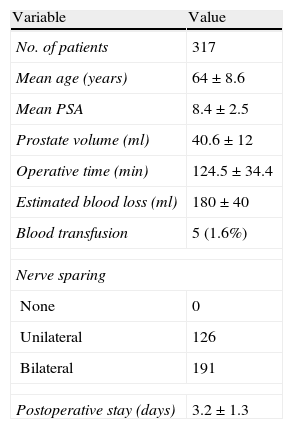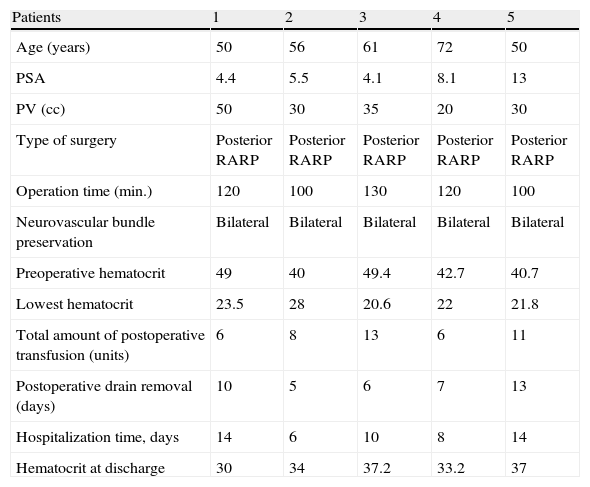Robotic-assisted radical prostatectomy (RARP) is the minimally invasive surgical treatment for patients with localized prostate cancer. Perioperative or postoperative complications following RARP have been reported in some studies and severe postoperative bleeding after RARP is rare, but haemodynamic instability may necessitate open surgical exploration and be associated with considerable morbidity. We reported postoperative bleeding cases, which is a kind of complication associated with robotic surgery and requiring massive transfusion after RARP.
Patients and methodsFrom August 2009 to May 2012, 317 consecutive patients who underwent RARP performed at our institution were analyzed. Patients with serious postoperative bleeding that caused haemodynamic instability after surgery were enrolled.
ResultsA total of 5 among 317 (1.6%) patients had bleeding requiring postoperative transfusion. In these cases, mean operative time was 114min. The mean estimated blood loss was 110ml during operation. In these patients, hematocrit (Hct) levels gradually fell after surgery and ecchymosis was detected on the side and posterior walls of the abdomen on the second day. The mean preoperative Hct was 44.3% and mean lowest Hct was 23.1%. All patients were successfully treated without surgical exploration.
ConclusionsRobotic radical prostatectomy has proven to be a safe surgical treatment with low morbidity. However, postoperative bleeding can reach serious problems. This is the first study to explain haemorrhage, associated with possible risk of robotic surgery.
La prostatectomía radical asistida por robot (PRAR) es el tratamiento quirúrgico mínimamente invasivo para los pacientes con cáncer de próstata localizado. Se han notificado complicaciones perioperatorias o postoperatorias después de PRAR en algunos estudios, y el sangrado postoperatorio severo después de PRAR es poco común, pero puede ser que la inestabilidad hemodinámica requiera exploración quirúrgica abierta y se asocie con una morbilidad considerable. Informamos de casos de sangrado postoperatorio, que es una especie de complicación asociada con la cirugía robótica, y la necesidad de transfusión masiva después de PRAR.
Pacientes y métodosDesde agosto de 2009 hasta mayo de 2012 317 pacientes consecutivos sometidos a PRAR en nuestra institución fueron analizados. Los pacientes con hemorragia postoperatoria grave, que causó inestabilidad hemodinámica después de la cirugía, fueron estudiados.
ResultadosUn total de 5 de entre 317 (1,6%) pacientes tuvieron hemorragia que requería transfusión postoperatoria. En estos casos la media de tiempo operatorio fue de 114min. La media de pérdida estimada de sangre fue de 110ml durante la operación. En estos pacientes los niveles de hematocrito (Hct) gradualmente disminuyeron después de la cirugía, y se detectó equimosis en las paredes laterales y posteriores del abdomen en el segundo día. El Hct preoperatorio medio fue de 44,3% y el Hct medio más bajo fue de 23,1%. Todos los pacientes fueron tratados exitosamente sin exploración quirúrgica.
ConclusionesLa prostatectomía radical robótica ha demostrado ser un tratamiento quirúrgico seguro con baja morbilidad. Sin embargo, el sangrado postoperatorio puede llegar a problemas serios. Este es el primer estudio para explicar la hemorragia asociada con el posible riesgo de la cirugía robótica.











